Almost the number of multiple trails collectively called the Ho Chi Minh Trail, this parallel being a natural boundary used in colonial days to distinguish between North and South Viet Nam. The next leg was to return across it.
Dong Ha, a big city, as nothing much going for it in itself other than Mr Binh (Bean). With good English, he's a tour guide and was hustling me gently. Met him several times including at the tunnels with a Canadian 'victim'. It was Mr Binh who advised me not to take the old trail road from Khe Sanh back north, difficult and dangerous he said. It was with reluctance I followed his advice after those mechanical problems. He appeared to say bye at the gas station.
Where ever you go and what ever you do, the war pops up. The father of Mr Vu(Rain), owner of the internet cafe I used, worked with the CIA. Mr Vu, a graphic designer, had to go to Korea before finally returning.
So up to Dong Hoi, a real easy but boring ride on Highway No1, a rapidly expanding river come seaside fishing resort town. Lots of boats with bamboo woven coracle tenders made watertight by a thick coating of tar on each side, powered by a single paddle. Baked sea fish and a couple of local Huda beers by the breezey river mouth made for an easy day and a good night's sleep.
Off to Phong Nga, the vast caves used by the North Vietnamese in the war as a hospital and a logistics base to send supplies down the Trail. The caves are now a UNESCO World Heritage site presumably for their natural beauty as apposed to the representation of determination shown by the north Vietnamese . Arriving too late for the full tour I found a nicely hosted guest house in Son Trach who kindly gave me, and you, this gratis internet use and blog.
Cluster Bombs in Casing
Project Pineapple
Remember, go to Archives for full story at bottom of picture column
SPECIAL UPDATE FOR AMERICANS
FOR NON AMERICANS PLEASE PASS ON TO YOUR US FRIENDS AND CONTACTS
PLEASE VIEW SITE
http://www.handicap-international.us/our-fight-against-landmines-and-cluster-bombs/in-brief/
AND FIND LINK TO
National Senate Call-In Day to Ban Cluster Bombs MAR 30
but keep up the pressure after this date
MAKE SURE YOU CONTACT YOUR SENATOR
ALSO for those who wish to make donations to Handicap International, a co-founder of the International Campaign to Ban Landmines (ICBL) which was awarded the Nobel Peace Prize in 1997, and now widely recognized as a key international lobbyist on weapons of war, please got to:
http://apps.facebook.com/causes/285080?m=96aaaf39
Be sure to contact your political representative too wherever you are.
PROJECT PINEAPPLE INITIATED WITH A MOTORCYCLE RIDE THROUGH INDOCHINA TO PUBLICISE THE CLUSTER BOMB ISSUE.
Laos was carpet bombed along the Vietnam border to wipe out the VietCong's supply lines, the multiple trails known as the Ho Chi Minh Trail. Now, the issue is still being swept under a diplomatic carpet.
The Iraq war opened on 19th March, 2003, with Cluster Bombs being dropped. I was in Laos walking through remote villages on a water well project when I got the news on my short wave radio. Those same villages were carpet bombed 35 years earlier and still living under the threat of 76 million unexploded Cluster Bombs.
Billions of dollars continue to be spent on Iraq but a mere 500 thousand dollars annually on clearing unexploded Cluster Bombs in Laos.
The Vietnam War ended on 30th April 1975 when the last ten marines were choppered out.
I used the Belarusian 125cc Minsk motorcyle to ride from Hanoi, Vietnam, through Laos and Cambodia to Ho Chi Minh City between 19th March and 30th April representing respectively the start of Cluster Bombs being dropped on Iraq and the final withdrawal of US marines from Saigon.
Visits were made to various relevant projects and programs both for clearing unexploded bombs and supporting the victims.
Should you be in any of these countries it is worth
finding out what you can about this 'forgotten' problem. Rural children and adults are still dying and being maimed every day.
Please email any comments to : project.pineapple@yahoo.com
Remember to go to Blog Archives at bottom of Picture column for the full story.
See you around
Robert
SPECIAL UPDATE FOR AMERICANS
FOR NON AMERICANS PLEASE PASS ON TO YOUR US FRIENDS AND CONTACTS
PLEASE VIEW SITE
http://www.handicap-international.us/our-fight-against-landmines-and-cluster-bombs/in-brief/
AND FIND LINK TO
National Senate Call-In Day to Ban Cluster Bombs MAR 30
but keep up the pressure after this date
MAKE SURE YOU CONTACT YOUR SENATOR
ALSO for those who wish to make donations to Handicap International, a co-founder of the International Campaign to Ban Landmines (ICBL) which was awarded the Nobel Peace Prize in 1997, and now widely recognized as a key international lobbyist on weapons of war, please got to:
http://apps.facebook.com/causes/285080?m=96aaaf39
Be sure to contact your political representative too wherever you are.
PROJECT PINEAPPLE INITIATED WITH A MOTORCYCLE RIDE THROUGH INDOCHINA TO PUBLICISE THE CLUSTER BOMB ISSUE.
Laos was carpet bombed along the Vietnam border to wipe out the VietCong's supply lines, the multiple trails known as the Ho Chi Minh Trail. Now, the issue is still being swept under a diplomatic carpet.
The Iraq war opened on 19th March, 2003, with Cluster Bombs being dropped. I was in Laos walking through remote villages on a water well project when I got the news on my short wave radio. Those same villages were carpet bombed 35 years earlier and still living under the threat of 76 million unexploded Cluster Bombs.
Billions of dollars continue to be spent on Iraq but a mere 500 thousand dollars annually on clearing unexploded Cluster Bombs in Laos.
The Vietnam War ended on 30th April 1975 when the last ten marines were choppered out.
I used the Belarusian 125cc Minsk motorcyle to ride from Hanoi, Vietnam, through Laos and Cambodia to Ho Chi Minh City between 19th March and 30th April representing respectively the start of Cluster Bombs being dropped on Iraq and the final withdrawal of US marines from Saigon.
Visits were made to various relevant projects and programs both for clearing unexploded bombs and supporting the victims.
Should you be in any of these countries it is worth
finding out what you can about this 'forgotten' problem. Rural children and adults are still dying and being maimed every day.
Please email any comments to : project.pineapple@yahoo.com
Remember to go to Blog Archives at bottom of Picture column for the full story.
See you around
Robert
One Reason for the Name Project Pineapple

America versus China
Tuesday, March 31, 2009
Subscribe to:
Post Comments (Atom)
Another Good Reason for Name Project Pineapple

This cluster bomb, known as a pineapple, which is still active, is in the collection of Tourist Information at Phonsavan, Plain of Jars, Laos
Two Good Reasons for Image on Project Pineapple Logo

Cope publicity staff Soksai 'plays' Project Pineapple logo
Mr Ta, No Arms One Eye, Cluster Bomb Victim

This is what the ride is about, to stop the perpetrators of these weapons
An Animated Mr Ta Gesticulates....

....as best he can during interview with COPE's Cluster Bomb display behind
'Handling' His Misfortune by Selling Maps at War Museum, Sai Gon

This victim armless, one legged, one eye, is pragmantic, I shook his 'hand' with both of mine
Arms and Legs All Over The Place

That's COPEs limb fitting centre, not going out of business soon, unfortunately.
Colourful Collection of Cluster Bombs

A tasty collection, you can see why kids enjoy playing with them
Togehter We Can Make It Happen

Bomb Awareness Day in Vientiane, is that an American flag I see before mine eyes?
Out of Nong Across to Along and The Hardest Trail

The Along villagers build this crossing during the dry season with a hefty toll on the otherside
War Vet Wonders Where The Good Times Went, And His Leg

The restrained display opposite the City Opera House on Le Loi Avenue, Sai Gon
International Artist Supports Project Pineapple
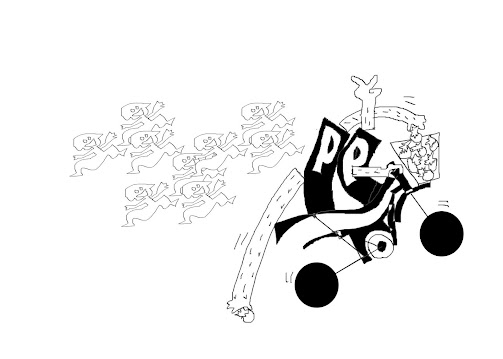
Man Winkler's contribution to the project , see blog entry, April 22
Little Remains After 40 Years of Scrap Hunters

Too big with rusted bolts for the recycling confirms you are on the Trail
Forest Fire

Sunset on Lao at the Viet Nam border. Imagine these skies on real fire 40 years ago.
Descendant of First Generation Clearance Team

Pigs, Dogs and Children were the first to clear UXOs before western conscience finally activated, see website
Jettisoned Fuel Tank Takes to the Air Again

B52s dropped their supplimentary fuel tanks after their deadly Cluster Bomb missions
UXO Lao Xekong meet Project Pineapple

Mr Tawee and some of his crew receiving COPE's brouchures
Mountain Villagers Have Little But The Land They Live On

Why should these people be suffering from the war remants so flagrantly scattered 40 years ago?
Complex Weaving Designs Take a Complex Comprehension

Villagers skilled in weaving intricate designs easily capable of searching their mountainous forest floor plan
Unstoppable Road Development of the Ho Chi Minh Trail

Parking a Minsk even for a moment can be hazardous
Minsk 125cc 2002
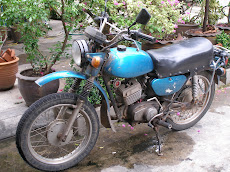
Your going on that? remarked Tony, the web man.
What's that Minsk doing up there?

It's on the way to my 'local' mechanic in Luang Prabang of course.
My 'Local' Mechanic
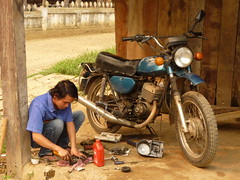
Hey Joe, Second Gear, not Top Gear
A Jarring Ride
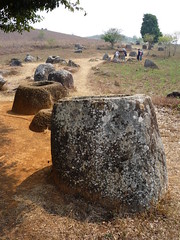
Phonsavan, Pathet Lao stronghold
Hanoi, Minsk's Second Fix

Snagging repairs after first fix
The Ride Kickstarts

Project Pineapple departs from Bach Mai Hospital, Hanoi
The Big House Pitstop

Not reaching the start of the Ho Chi Minh Trail on the first day we make a pitstop at this fine traditional Big House.
Cam Thuy, Start of the Ho Chi Minh Trail

Outside the restaurant, our last meal together before they head north and I south
Project Pineapple Riders

Ben from Australia, with 32 biking trophies to his name, rides the Minsk in Hanoi
Ho Chi Minh's Birth Place

Not far off the Trail to which he gave it's name, Uncle Ho's house
Phong Nga Cave's now Toothless Mouth

Like Venice, Cave Gondaleers have time
Spooked at Trail Crossroads

Tien with Jokers Alain and Ludivec
Moody Mountains of Mordor

The Spooky crossroads of the Trail
Friendly French

Missing a gear change causes a photo op returning to the caves
Chain of Events cause Delays

Tuan speedily replaces clutch and drive chain




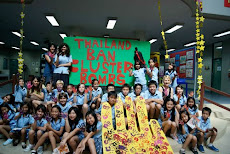


































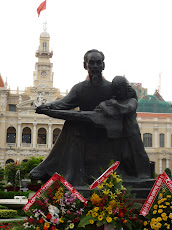















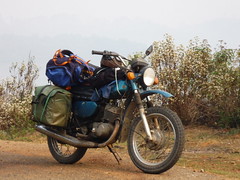







No comments:
Post a Comment